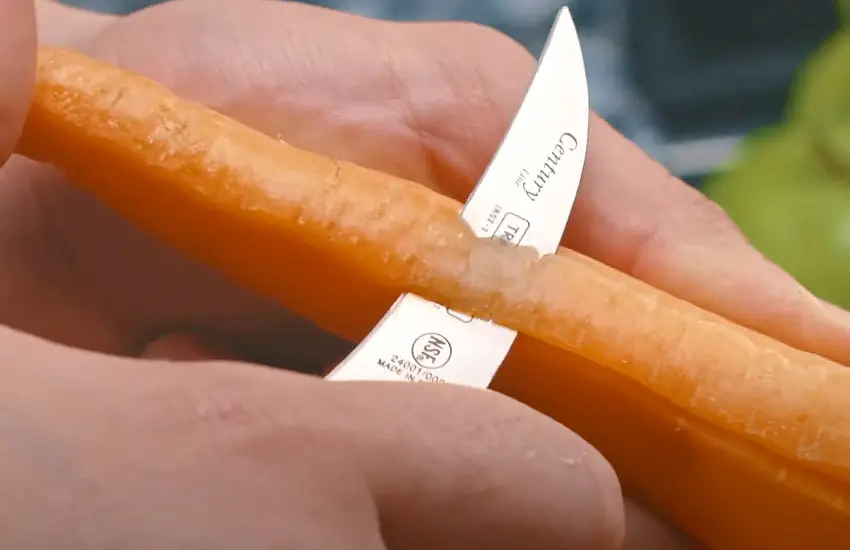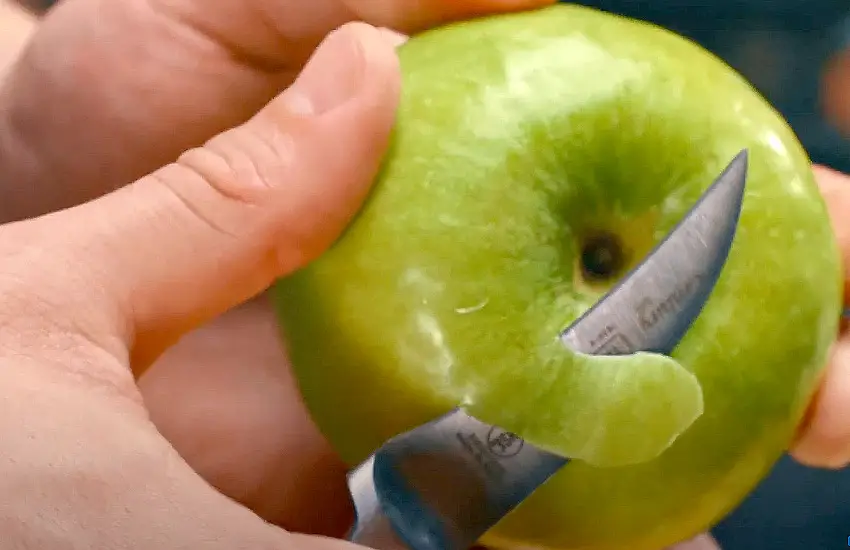As an Amazon Associate, I earn from qualifying purchases at no extra cost to you.
How to Use a Curved Paring Knife: A Quick Guide for Beginners!
Using a bread knife may seem like a simple task, but there’s an art to achieving those perfect, even slices. In this article, we’ll break down the basics of how to use a bread knife with ease.
From selecting the right knife to mastering the proper technique, you’ll soon be cutting through loaves like a pro. Whether you’re a novice in the kitchen or just looking to up your bread game, this step-by-step tutorial will have you confidently wielding your bread knife and enjoying consistently beautiful slices.

Choosing The Right Curved Paring Knife
When it comes to choosing the right curved paring knife, there are a few key factors to consider. The right knife can make a world of difference in the kitchen, from effortlessly peeling and slicing fruits and vegetables to creating intricate designs for garnishes. Let’s take a closer look at what to consider when selecting a curved paring knife.
Consider The Blade Length
The blade length of a curved paring knife is an important consideration when choosing the right one for your needs. A shorter blade, typically around 3 inches, offers greater control and precision for intricate tasks such as peeling and shaping.
Conversely, a longer blade, around 4 inches, provides more surface area for cutting larger fruits and vegetables. Consider the types of tasks you will be using the knife for and choose a blade length that aligns with your needs.
Look For A Comfortable Handle
A comfortable handle is essential for ensuring a firm grip and reducing strain during prolonged use. Look for a paring knife with an ergonomic handle that fits comfortably in your hand, providing stability and control.
Additionally, consider the material of the handle; options include wood, plastic, or metal. Choose a handle material that suits your preferences and provides a comfortable grip for extended use.
Mastering The Technique
A curved paring knife is a versatile tool that can make your kitchen tasks much easier. However, using it correctly requires some practice and skill. In this section, we will explore some essential techniques that can help you master the art of using a curved paring knife effectively.
Hold The Knife Correctly
Properly holding the knife is the foundation of using any knife effectively. To hold a curved paring knife correctly:
- Grip the handle firmly with your dominant hand, making sure it feels comfortable.
- Place your index finger on the spine (back) of the knife, just above the handle.
- Wrap your remaining fingers around the handle, maintaining a secure grip.
- Rest your thumb on the side of the blade, opposite to the convex curve.
By holding the knife in this way, you’ll have better control and precision over your cuts.
Practice Controlled Slicing
Controlled slicing is essential for safe and efficient knife work. When using a curved paring knife, consider the following techniques:
- Start by placing the tip of the knife against the cutting surface and lower the blade gently.
- Apply gentle pressure and use a sawing motion to slice through the food, maintaining control.
- Avoid forcing the knife or using excessive pressure, as it can lead to accidents or an inconsistent cut.
- For curved cuts, such as peeling fruits or vegetables, move the knife using a rocking motion to utilize the curve.
With practice, you’ll develop the skills needed to slice with precision and efficiency.
Utilize The Curved Shape
The curved shape of a paring knife is specifically designed to enhance certain kitchen tasks. Here are some ways to make the most of its unique shape:
- When peeling, use the curve of the blade to follow the contours of the fruit or vegetable, ensuring minimal waste and maximum efficiency.
- The curved shape is also great for removing seeds from peppers or coring fruits. Simply insert the tip of the knife and cut around the core using a twisting motion.
- For delicate tasks like deveining shrimp or trimming fat from meat, the curve allows for precise movements.
By utilizing the curved shape of the knife, you can tackle various kitchen tasks more effectively.
Tips For Preparing Different Ingredients
Discover expert tips for using a curved paring knife to efficiently prepare a variety of ingredients. Elevate your culinary skills with these valuable techniques that will make your food prepping process a breeze.
Prepping Fruits And Vegetables
Using a curved paring knife to prepare fruits and vegetables can make your kitchen tasks quicker and more efficient. The curved blade allows for precise, controlled movements that help you achieve uniform cuts and slices. Here are some tips to make the most out of your curved paring knife when prepping various fruits and vegetables:
Cutting Hard-Textured Fruits and Vegetables
- Apples: Start by cutting off the top and bottom to create a stable base. Then, follow the natural curve of the fruit, using downward strokes to remove the skin or make thin slices.
- Potatoes: Use the curved paring knife to peel the skin from the potato, making long, sweeping motions. For slicing, first cut off any irregular parts, then position the blade at a slight angle to achieve consistent thickness.
- Carrots: Begin by cutting off the ends of the carrot. Hold the carrot at an angle and use the curved blade to slice off the skin in a smooth motion. To make even slices, position the knife at an angle and gently glide it through the carrot.
Preparing Delicate Fruits and Vegetables
- Tomatoes: Place the tomato on a cutting board with the stem side facing down. Use the curved paring knife to make gentle sawing motions, ensuring the blade never pierces the skin. This technique results in clean, even slices.
- Mushrooms: Hold the mushroom with one hand while using the curved paring knife to remove the stem. Use the tip of the blade to carefully slice the mushroom cap, making thin, even pieces.
- Avocado: Cut the avocado in half lengthwise and remove the pit. Holding the avocado half, use the curved paring knife to make thin, vertical slices. Then, make horizontal cuts to achieve evenly shaped cubes.
Slicing Meat And Poultry
A curved paring knife is not just limited to fruits and vegetables; it can also be handy when dealing with meat and poultry. The curved blade allows for precise, controlled cuts that help retain the juices and flavors of the meat. Here are some tips for slicing meat and poultry:
Preparing Meat Steaks
- Beef: Start by trimming any excess fat from the steak. Hold the curved paring knife at a slight angle and use long, smooth motions to slice through the meat. This technique helps in achieving consistent thickness.
- Pork: Similar to beef, trim off any excess fat before slicing. Hold the curved paring knife at a slight angle and make controlled, downward cuts to get even slices.
- Chicken Breast: Place the chicken breast flat on a cutting board, and holding the curved paring knife at a slight angle, slice through the meat in smooth, continuous strokes. This technique helps in achieving uniform slices for even cooking.
Carving Poultry
When it comes to carving a whole roasted chicken or turkey, a curved paring knife can be a game-changer. Its curved blade allows you to navigate around bones, resulting in clean and effortless cuts. Here’s how to use the curved paring knife for carving poultry:
- Separating the Breast: Hold the roasted bird steady and use the curved paring knife to make a horizontal cut along the breastbone. Gently separate the breast meat from the bone by using the knife in a sawing motion.
- Cutting the Thighs and Wings: Use the curved blade to cut through the joints that connect the thighs and wings to the body. Apply controlled pressure to ensure clean cuts.
- Slicing the Breast Meat: Position the curved paring knife at a slight angle and make thin, even slices across the grain of the breast meat. This technique enhances tenderness and makes the meat easier to chew.
By following these tips, you’ll unlock the full potential of your curved paring knife, allowing you to prep various ingredients with precision and efficiency. Remember, practice makes perfect, so don’t be afraid to experiment and discover new ways to utilize your curved paring knife in the kitchen.
Caring For Your Curved Paring Knife
A well-maintained curved paring knife can make all the difference in your kitchen. Caring for your knife properly will ensure its longevity and efficiency. Here’s how you can ensure that your curved paring knife remains in top condition for all your culinary needs.

Clean And Dry Properly
After each use, clean your curved paring knife with mild soap and warm water. Be sure to use a gentle hand and avoid harsh scrubbing to prevent damage to the blade. Once clean, thoroughly dry the knife with a soft cloth before storing it. Moisture can lead to rust and corrosion, so keeping the blade dry is crucial in maintaining its quality.
Sharpen Regularly
To maintain the sharpness of your curved paring knife, it’s important to sharpen it regularly. You can use a knife sharpener or a honing steel to keep the blade edge at its best. Regular sharpening ensures that your knife remains effective for precise cutting tasks and reduces the risk of accidents due to dull blades.
Final Words
The curved paring knife is a versatile tool for precision cutting and peeling. By using the proper technique and following safety guidelines, this kitchen essential can make food preparation more efficient and enjoyable. With its unique design and functionality, the curved paring knife is a valuable addition to any cook’s kitchen arsenal.
